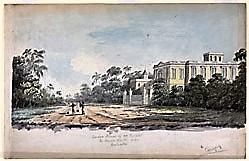

Concert V & A
July 1st — 7.30 p.m. Lecture Hall
An Oriental Miscellany
Calcutta Band and Singers
Directed by Raymond Head (piano)
Bronwen Mills — Soprano
Judith Hilary-Simmons — Contralto
Christopher Gillett — Tenor
Colin Davis — Bass
The original Calcutta Band was a group of Europeans in Calcutta who, in the late eighteenth century played at special “entertainments and balls. Individual members of the Band were professional musicians, teachers, instrument makers and repairers who played in benefit and subscription concerts. They played music by composers such as Corelli, Geminiani, Handel and Avison as well as the latest works by composers such as Haydn and Stamitz.
Today’s Calcutta Band was founded in 1981 to draw attention to the Indian influences on European music.
| Overture: Ramah Droog Allegro Moderato; Andante; Spiritoso |
— Mazzinghi (ed. R Head) |
| Songs and Glees | |
| Hindoo Hymn | — Trinks |
| Let Not Sorrow | — Biggs |
| Yes, Yes tis Love | — Biggs |
| Vivace for piano | — Trinks |
| Stay Gentle Damsel | — Biggs |
| A Hunting Song | — Biggs |
| Dil Ne Danne Leea (Urdu: Don’t give your heart away my darling) | — Trinks |
| Subjo Ka Tullav Hove (Urdu: When Dawn appears) for piano | — Trinks |
| On Spring | — Biggs |
| Symphony No. 30 in C (Alleluja) Allegro; Andante; Finale: tempo di menuet |
— Haydn |
and works by Delibes and John Foulds

In the last two decades of the 18th century India made a quite unprecedented impact on the social and political scene in Britain. Influence was also felt in art, principally through the work of Thomas Daniell, and literature through the investigations and translations of Sir William Jones and Charles Wilkins. Hitherto it has been thought that music was influenced only through an increasing predeliction for “oriental” plots based upon the Arabian Nights, rather than any direct influence. However, research has brought to light some compositions based upon Indian music and some of these are to be played in the concert.
Ramah Droog certainly contains no such direct references. It was composed by Joseph Mazzinghi (1765-1844), an English composer of Corsican origins who had studied with J. C. Bach. At the age of 19, Mazzinghi was appointed musical director of the King’s Theatre, London, for which he produced an enormous output of stage works of doubtful value. Ramah Droog, to a libretto by the East India Company civil servant James Cobb, was first performed at Covent Garden in 1798. The plot, set in the time-of the Mysore Wars, captured the imagination of a public familiar with Britain’s intervention in Mysore and the fame of the unjustly maligned Tipu Sultan. Such a setting permitted the fullest expression of Britain’s ignorant orientalisms. However, the spirited overture is worth performing. Added interest was contributed to the production by the use of Thomas Daniell’s scene designs, derived from his aquatint series Oriental Scenery. Their use endeavoured to conjure up an atmosphere of authenticity – much as Samuel Pepys Cockerell was to attempt in architecture at Sezincote, and Thomas Moore in the epic poem Lalla Rookh. The frontispiece of the vocal score of Ramah Droog contains a reproduction of Daniell’s View of the fort at Tritchinoply. Ramah Droog continued to be popular for thirty years, – its spectacular production influencing the imagination of the artist John Martin. The overture has been edited for performance from an incomplete set of parts now in the Manchester Public Library.
In 1789 William Bird published An Oriental Miscellany. This contained transcriptions of Indian popular music for harpsichord or piano preceded by a short introduction which explained the difficulty of bringing “Hindoo” music. into some regularity. The effort was worthwhile, he wrote in his introduction, because they possessed some grace and charm. The melodies, tappas, taranas and rekhtas were transcribed with simple harmonisations followed by variations. Three hundred copies were printed and Bird’s own copy is now in the Royal College of Music. They were distributed to nearly all the members of the Civil and Military establishments in Calcutta. It is clear that he was fulfilling a need. For not only did some of the English people sing the songs in the original languages but they themselves made manuscript collections of the music. Some of the songs became particularly popular. Rewanah Kisty was used by Bishop in his opera Englishmen in India, Dil Ne Donne Lea was sung in Persian on the stage of Covent Garden in 1802, in an opera by Charles Smith entitled A Trip to Bengal. Charles Horn was another composer who drew on Bird’s Miscellany.
Ursula Sims-Williams, The British Library
Raymond Head, Royal Asiatic Society